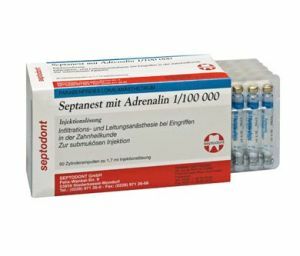 Septanest with adrenaline( Septanest with Adrenaline) is used for conductive and infiltration anesthesia in dentistry. Fully meets WHO quality standards.
Septanest with adrenaline( Septanest with Adrenaline) is used for conductive and infiltration anesthesia in dentistry. Fully meets WHO quality standards.
The medication is used, both for local anesthesia and for local-regional.
Due to modern development the preparation is characterized by a minimum of side and allergic reactions.
content
- features and characteristics of the composition
- Pharmacological properties
- Scope and contraindications
- Instructions for use
- Adult dosages
- dosage for children
- dosage for elderly
- method of administration
- Pregnancy and lactation
- cautions and use nuances
- Side effects
- overdose cases
- Therapy of intoxication
- Inappropriate combination of
- preparations Cost and analogues
Characteristic and especiallyti composition
Septanest available in dosages of 1: 100,000 and 1: 200,000, the product contains the following active ingredients:
- articaine hydrochloride 68 mg;
- Epinephrine Hydrogen Tartrate( adrenaline) 30.94 μg( equivalent to 17 μg epinephrine) in 1 filled ampoule( 1.7 ml).
Additional components included in the preparation:
- sodium metabisulphite;
- sodium chloride;
- disodium edetate;
- sodium hydroxide solution 1 mol / l to adjust the pH;
- water.
The dosage form is represented by a transparent injection solution. Shelf life: 2 years.
Special measures and recommendations for storage of the preparation are as follows: 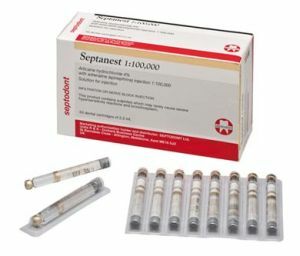
- in the original packaging at a temperature of 25 ° C, protecting from light;
- protect from frost.
Type and size of package: ampoule( cartridge) of colorless glass. Ampoules are stored in PVC form with a protective paper lid.
Packing size: 50x1, 7 ml.
Pharmacological properties
The drug belongs to the group of anesthetics. ATS code: NO1 BB 58.
Articaine is a local anesthetic agent of the amide type, which prevents the spread of a nerve impulse along the nerve fibers.
Adrenaline added to a solution of articaine causes a local narrowing of the vessels, thereby slowing the absorption of the latter into the blood, respectively, increasing the concentration of the active drug in the tissue. This helps create a bloodless surgical field.
The anesthetic effect comes quickly, only 2-3 minutes after the injection. The analgesic effect lasts about 60 minutes. The anesthetic effect in the pulp is 2-3 times less.
When the drug is administered to the oral mucosa, the active ingredient reaches a maximum concentration in half an hour.
The time of plasma half-life of articaine is within 110 minutes. The substance in the form of a metabolite is excreted by the kidneys, 5-10% leaves with urine in an unchanged form.
Studies conducted on animals indicated a good tolerability of the drug.
Analogously to other local anesthetic agents such as amide, toxic reactions may occur during an overdose.
Scope and contraindications
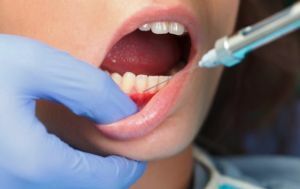 The drug is used for regional and local sensitivity reduction in maxillofacial surgery and dentistry.
The drug is used for regional and local sensitivity reduction in maxillofacial surgery and dentistry.
The most commonly used septanest is the introduction of intraligamentary, conductive and infiltration anesthesia.
Contraindications to use:
- Known hypersensitivity to any of the components of the medication;
- conduction disorder of the cardiac system;Incurable epilepsy;
- high sensitivity to sulfur compounds( usually in individuals with bronchial asthma);
- paroxysmal tachycardia;
- heart failure;
- glaucoma.
Because of the adrenaline content, caution and careful monitoring are necessary in cases in which the patient has a history of:
- arrhythmia;
- coronary insufficiency;
- severe hypertension.
In case of severe hepatocellular insufficiency, taking into account the predominantly hepatic metabolism of local anesthetics such as amide, it is necessary to reduce the dose of the drug. It should be reduced also with metabolic acidosis, hyperkalemia or hypoxia.
Instruction for use
The drug is used to treat patients aged 4 years!
Adult doses of 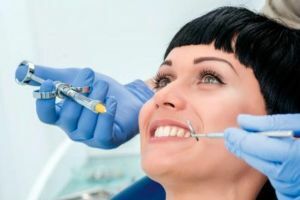
Dosage can be adjusted depending on the intensity and duration of the intervention.
For standard conductive anesthesia, the drug is used in the amount of 1 ampoule.
The total dose for a single visit to the dentist does not exceed 7 mg of articaine / kg of the body weight of the patient.
Dosage for children
The total dose is 5 mg articaine / kg body weight.
The optimal dose in mg can be calculated by the following way: child weight( kg) x1.33.
Dosage for the elderly
The dose applied to adults is reduced by half.
Mode of administration
The drug can not be administered intravascularly. Before the injection, it is advisable to perform an aspirate test.
Injection speed: not more than 1 ml / min.
Pregnancy and lactation
Animal experiments did not show teratogenic effects. In view of the absence of teratogenic effect in animals, no toxic effect is expected on the fetus of the pregnant woman.
Currently, there are controlled clinical studies proving that substances with teratogenic effects on the human fetus are teratogenic in animals.
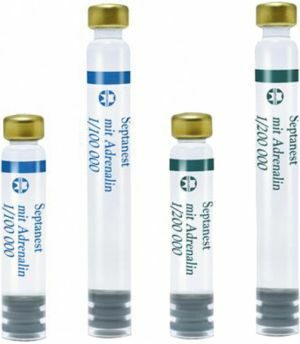 At present, however, there are no clinical trials that unequivocally disprove the toxic or teratogenic effect of atrikain during pregnancy.
At present, however, there are no clinical trials that unequivocally disprove the toxic or teratogenic effect of atrikain during pregnancy.
Therefore, during pregnancy, if it is necessary to perform dental and surgical procedures, it is recommended that Septaptest be used only in case of emergency.
The components of the drug do not penetrate the breast milk in pharmacologically significant concentrations. Continuation of lactation is possible after weakening the analgesic effect.
Cautions and Nuances for Use
The drug contains epinephrine!
In exceptional cases, necrosis of local tissues is possible in patients with hypertension or diabetes.
Because of the potential decrease in swallowing capacity due to anesthesia( numbness in the mouth, facial area, mucous membranes, tongue), there is a risk of aspiration. It is necessary to warn the patient that during the impact of anesthesia one should not have chewing gum or food in the mouth.
The drug is not used in the area of infected or inflamed tissue, otherwise it may reduce the effect of local anesthetic.
Anesthetic contains an active substance, the presence of which can cause a positive reaction when doping control athletes.
To avoid the risk of developing allergic reactions to the components of the drug, it is necessary to test for sensitivity( introduction of about 5-10% of the dose intended for local anesthesia).
The drug should be administered slowly, extravasely, with simultaneous control of breathing. Increased observation is necessary in the treatment of patients undergoing anticoagulant therapy.
Side effects of
Similarly, as with all other local anesthetics used in dental surgery, lipotymia( a brief loss of consciousness) can occur.
The drug contains sulfites, which can cause or aggravate various allergic manifestations.
Undesirable reactions may result from accidental intravascular drug administration or excessive absorption by inflamed or vascularized tissues.
In predisposed individuals, multiple negative reactions from several body systems can occur.
CNS:
- headache;
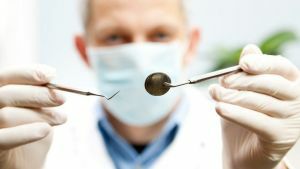
- is nervous;
- drowsiness;
- nausea;
- tremor;
- excitement;
- concern;
- nystagmus;
- ringing in the ears.
The presence of these symptoms is the reason for hyperventilation. It is important to carefully monitor the patient's condition in order to prevent worsening, development of seizures or CNS depression.
The respiratory system fails as follows:
- tachypnea;
- bradypnoe;
- apnea.
The cardiovascular system manifests itself as follows:
- tachycardia;
- lowering blood pressure;
- collapse;
- severe cardiac arrhythmias.
These abnormal heart rhythms can lead to cardiac arrest.
Overdose Cases
Overdose can occur in 2 types of toxic reactions:
- immediately after administration, eg in the case of abnormal intravenous administration;
- later, due to an actual local drug overdose.
Therapy of intoxication
If the first symptoms occur, the patient's lungs should be immediately hyperventilated and placed in a horizontal position. In case of seizures, oxygenation should be improved and the symptoms reduced by intravenous benzodiazepine.
In severe complications, intubation is performed.
Inappropriate combination of
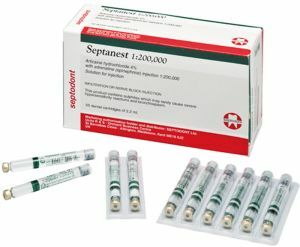 preparations It is important to pay attention to the use of Septaplast for the treatment of people who take other medicines.
preparations It is important to pay attention to the use of Septaplast for the treatment of people who take other medicines.
Because of the content of adrenaline, septanest with guanethidine and preparations of a similar type( antiglaucomatous drugs) should not be taken, since a significant increase in blood pressure is possible. With the simultaneous administration of these drugs, extreme caution and dose reduction are necessary.
With simultaneous administration with volatile halogenated anesthetics, sensitization of the myocardium is possible. Precautions include reducing the dose of epinephrine to a dose of 0.1 mg / 10 min or 0.3 mg / h for adults.
When taken with tricyclic antidepressants, there is a risk of paroxysmal hypertension with arrhythmia.
Precautions include reducing the dose of epinephrine to a dose of less than 0.1 mg / 10 min or 0.3 mg / hour for adults.
Cost and analogues
The price of the drug Septeste varies between 2400-2500 rub, also available with the same effect: 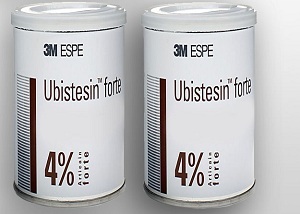
- Alfacaine;
- Artikine;
- Brilocaine;
- Primacaine;
- Ubestesin;
- Ultracaine;
- Cytochrome.
